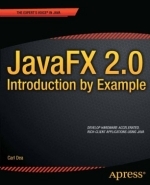JavaFX 2.0: Introduction by Example by Carl Dea

Категория: Other
Поделиться:
Introduction JavaFX 2.0 is Java’s next generation graphical user interface (GUI) toolkit for developers to rapidly build rich cross-platform applications. Built from the ground up, JavaFX takes advantage of modern GPUs through hardware-accelerated graphics while providing well-designed programming interfaces enabling developers to combine graphics, animation, and UI controls. The new JavaFX 2.0 is a pure Java language application programming interface (API). The key architectural strategies provided by JavaFX 2.0 API are the reuse of existing Java libraries and the bridging of communication between other languages that run on the JVM (Visage, Jython, Groovy, JRuby, and Scala). Nandini Ramani of Oracle plainly states the intended direction of JavaFX the platform in the following excerpt from the screencast, Introducing JavaFX 2.0:
“The industry is moving toward multi-core/multi-threading [type] platforms with GPUs. JavaFX 2.0 leverages these attributes to improve execution efficiency and UI design flexibility. Our initial goal is to give architects and developers of enterprise applications a set of tools and APIs to help them build better data driven business applications.” —Nandini Ramani Oracle Corp. VP of Development, Java Client Platform
Скачать
Комментарии